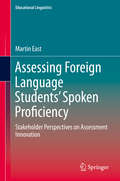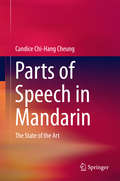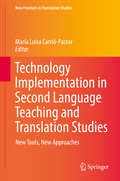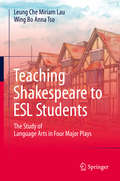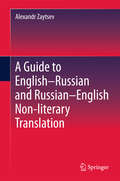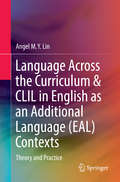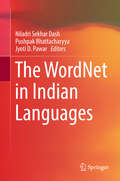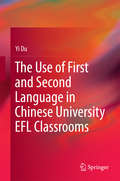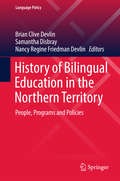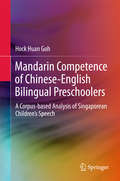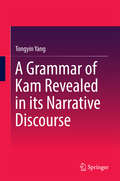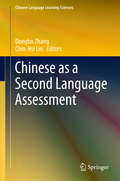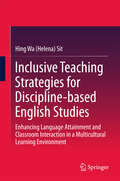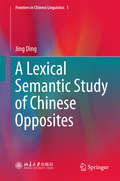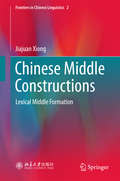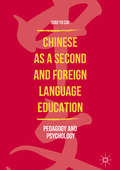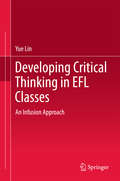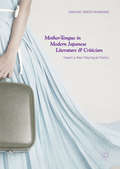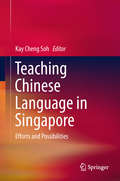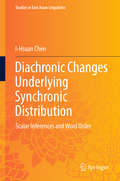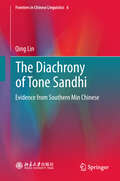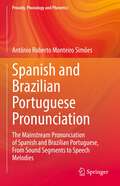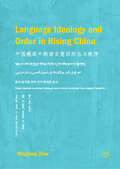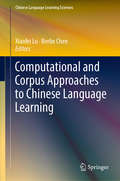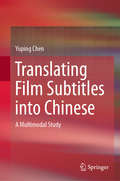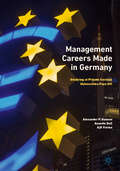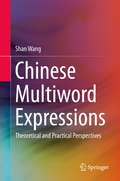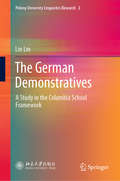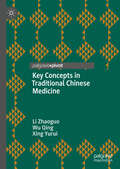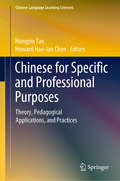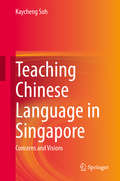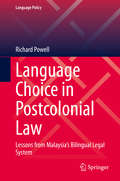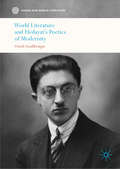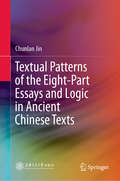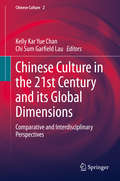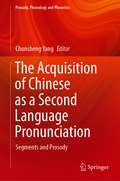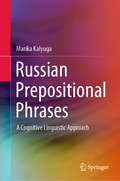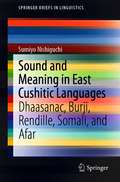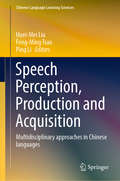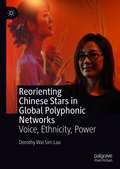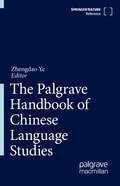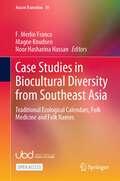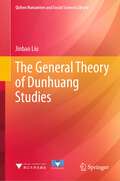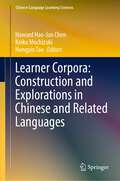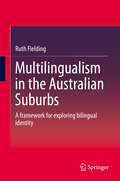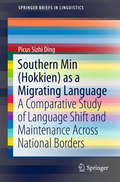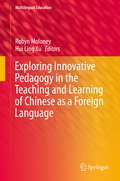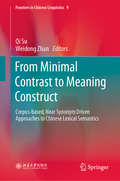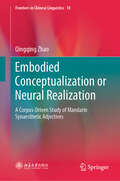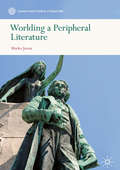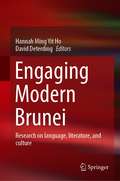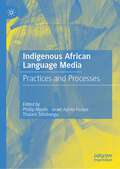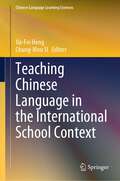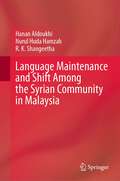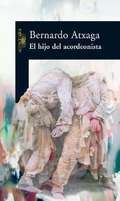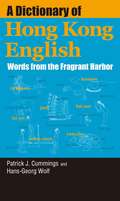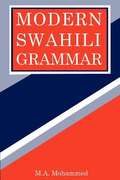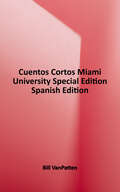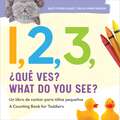- Table View
- List View
Assessing Foreign Language Students' Spoken Proficiency: Stakeholder Perspectives on Assessment Innovation (Educational Linguistics #26)
by Martin EastThis book presents an indepth study of assessment innovation and its impact on teaching and learning. The context is New Zealand, and the focus is additional languages other than English and the recent introduction of a radical new assessment of students' spoken proficiency, called interact. The book crosses the traditional theoretical and methodological boundaries associated with language testing research, which focuses on assessment performance, and presents an alternative approach where stakeholders become the centre of interest. It advances our understanding of how assessment innovation impacts on two key groups - teachers and students in schools - based on data collected from a substantial twoyear research project. It presents an account of these stakeholders' perceptions of the validity and usefulness of the new assessment in comparison with the more traditional test that it has replaced. Assessing Foreign Language Students' Spoken Proficiency makes an outstanding and original contribution to the field of second and foreign language teaching, providing a theory and research-based account of the development of a learner-centred approach to oral proficiency assessment. It is an important resource for teachers and teacher educators as well as assessment and curriculum specialists worldwide. It deserves to be widely read.
Parts of Speech in Mandarin
by Candice Chi-Hang CheungThis book offers a comprehensive survey of the major parts of speech in Mandarin. Seeking to identify the sets of universal and language-specific categories, it compares the range of categories available in Mandarin and the Indo-European languages and establishes six universal categories - nouns, verbs, adjectives, adverbs, prepositions and conjunctions - and three language-specific ones, namely classifiers, localizers and sentence-final particles. Incorporating insights from recent research findings and the diachronic development of the language, the book sheds new light on the factors that contribute to the long-standing debate on the categorical status of adjectives, prepositions and localizers in the extant literature. Bringing together the earlier general descriptions and the latest advances, it is broadly accessible to non-native and native speakers of the language and offers an ideal reference source for all students and scholars who are interested in studying the parts of speech in Mandarin.
Technology Implementation in Second Language Teaching and Translation Studies
by María Luisa Carrió-PastorThis monograph mainly focuses on the idea that language teaching in higher education involves making use of new approaches and technology. It identifies the key determinants of the materials needed to improve language teaching on the basis of the actual experimental research included in the respective contributions. Thanks to its unique perspective, the book offers a distinctive approach to addressing empirical research on second language teaching, translator training and technology. As universities are some of the best arenas for analyzing teaching techniques for various subjects, higher education teachers can use this book to thoroughly prepare for the application of pilot studies and learn more about students' responses to new teaching and translation techniques. An enlightening guide for scholars and students with an academic interest in acquiring the basic principles of language teaching and translation, this book mainly provides actual cases in which the implementation of technology was useful to second language teachers and translation trainers. As the authors are experienced scholars, readers will not only come to understand how to use new teaching strategies, but also discover that the proposals described in each chapter can be useful to any level of second language training for teachers and translators.
Teaching Shakespeare to ESL Students
by Leung Che Miriam Lau Wing Bo Anna TsoThis is a teacher's resource book tailor-made for EFL teachers who want to bring Shakespeare into their classes. It includes forty innovative lesson plans with ready-to-use worksheets, hands-on games and student-oriented activities that help EFL learners achieve higher levels of English proficiency and cultural sensitivity. By introducing the plots, characters, and language arts employed in Macbeth, Romeo and Juliet, The Taming of the Shrew, and The Merchant of Venice, the book conveys English grammatical rules and aspects like a walk in the garden; complicated rhetorical features such as stress, meter, rhyme, homonymy, irony, simile, metaphor, euphemism, parallelism, unusual word order, etc. are taught through meaning-driven games and exercises. Besides developing EFL learners' English language skills, it also includes practical extended tasks that enhance higher-order thinking skills, encouraging reflection on the central themes in Shakespeare's plays.
A Guide to English-Russian and Russian-English Non-literary Translation
by Alexandr ZaytsevLying at the intersection of translatology, cognitive science and linguistics, this brief provides a comprehensive framework for studying, investigating and teaching English-Russian/Russian-English non-literary translation. It provides a holistic perspective on the process of non-literary translation, illustrating each of its steps with carefully analyzed real-life examples. Readers will learn how to choose and process multidimensional attention units in original texts by activating different types of knowledge, as well as how to effectively devise target-language matches for them using various translation techniques. It is rounded out with handy and feasible recommendations on the structure and content of an undergraduate course in translation. The abundance of examples makes it suitable not only for use in the classroom, but also for independent study.
Language Across the Curriculum & CLIL in English as an Additional Language (EAL) Contexts
by Angel M. Y. LinThis book will be of interest to a broad readership, regardless of whether they have a background in sociolinguistics, functional linguistics or genre theories. It presents an accessible "meta-language" (i. e. a language for talking about language) that is workable and usable for teachers and researchers from both language and content backgrounds, thus facilitating collaboration across content and language subject panels. Chapters 1 to 3 lay the theoretical foundation of this common meta-language by critically reviewing, systematically presenting and integrating key theoretical resources for teachers and researchers in this field. In turn, Chapters 4 to 7 focus on issues in pedagogy and assessment, and on school-based approaches to LAC and CLIL, drawing on both research studies and the experiences of front-line teachers and school administrators. Chapter 8 provides a critical and reflexive angle on the field by asking difficult questions regarding how LAC and CLIL are often situated in contexts characterized by inequality of access to the linguistic and cultural capitals, where the local languages of the students are usually neglected or viewed unfavourably in relation to the L2 in mainstream society, and where teachers are usually positioned as recipients of knowledge rather than makers of knowledge. In closing, Chapter 9 reviews the state of the art in the field and proposes directions for future inquiry.
The WordNet in Indian Languages
by Niladri Sekhar Dash Pushpak Bhattacharyya Jyoti D. PawarThis contributed volume discusses in detail the process of construction of a WordNet of 18 Indian languages, called "Indradhanush" (rainbow) in Hindi. It delves into the major challenges involved in developing a WordNet in a multilingual country like India, where the information spread across the languages needs utmost care in processing, synchronization and representation. The project has emerged from the need of millions of people to have access to relevant content in their native languages, and it provides a common interface for information sharing and reuse across the Indian languages. The chapters discuss important methods and strategies of language computation, language data processing, lexical selection and management, and language-specific synset collection and representation, which are of utmost value for the development of a WordNet in any language. The volume overall gives a clear picture of how WordNet is developed in Indian languages and how this can be utilized in similar projects for other languages. It includes illustrations, tables, flowcharts, and diagrams for easy comprehension. This volume is of interest to researchers working in the areas of language processing, machine translation, word sense disambiguation, culture studies, language corpus generation, language teaching, dictionary compilation, lexicographic queries, cross-lingual knowledge sharing, e-governance, and many other areas of linguistics and language technology.
The Use of First and Second Language in Chinese University EFL Classrooms
by Yi DuThis book investigates first language (L1) and second language (L2) use in Chinese university classrooms, focusing on the experiences of four Chinese EFL teachers who were teaching non-English major students at four different proficiency levels. It examines these four teachers' actual use of L1 and L2, including the distribution of their L1 and L2 use; the circumstances, functions and grammatical patterns of their language use; and their language use across different frames of classroom discourse. It also explores their attitudes and beliefs regarding this issue in depth, as well as their own perceptions of and reasons for their language use and possible influencing factors. Through its detailed analysis of the teachers' language use, as well as their respective beliefs and decision-making techniques, this book contributes to L2 teachers' professional development and L2 teaching in general, especially with regard to establishing a pedagogically principled approach to L1 and L2 use.
History of Bilingual Education in the Northern Territory
by Brian Clive Devlin Samantha Disbray Nancy Regine Friedman DevlinThis book provides the first detailed history of the Bilingual Education Program in the Northern Territory of Australia. This ambitious and innovative program began in 1973 and at different times it operated in English and 19 Aboriginal languages in 29 very remote schools. The book draws together the grassroots perspectives of Indigenous and non-Indigenous practitioners and researchers. Each chapter is based on rich practitioner experience, capturing bottom-up aspirations, achievements and reflections on this innovative, yet largely undocumented language and education program. The volume also makes use of a significant collection of 'grey literature' documents to trace the history of the program. An ethnographic approach has been used to integrate practitioner accounts into the contexts of broader social and political forces, education policy decisions and on-the-ground actions. Language in education policy is viewed at multiple, intersecting levels: from the interactions of individuals, communities of practice and bureaucracy, to national and global forces. The book offers valuable insights as it examines in detail the policy settings that helped and hindered bilingual education in the context of minority language rights in Australia and elsewhere.
Mandarin Competence of Chinese-English Bilingual Preschoolers
by Hock Huan GohThis book provides readers with a detailed sketch of the Mandarin competence of Chinese children in Singapore from different home language backgrounds. Their Mandarin competence is defined in terms of lexical diversity, syntactic complexity and code-switching tendency. The findings presented show that there are statistical differences in lexical diversity and syntactic complexity among the compared groups of children, and these differences in linguistic competence were found to be positively correlated to increased Mandarin exposure at home. They also demonstrate that there are statistical differences in code-switching tendency among the groups of children compared, which were found to be negatively correlated to increased exposure to Mandarin at home. A general relationship between home language exposure and Mandarin competence was established, although this relationship was found to be volatile, especially among children who are more bilingually exposed. This book shares these findings with linguists, language educators, and language policymakers, both local and international.
A Grammar of Kam Revealed in Its Narrative Discourse
by Tongyin YangThe Kam language of China possesses fifteen tones - more than any other language. Yet it has long been neglected as an area of research, especially from the perspective of discourse analysis. This study initiates the exploration of the interface between grammar and discourse by examining various aspects of Kam narrative discourse, and using a functional approach to reveal its structural properties. It also introduces the mechanism for phonological and syntactic variations, as well as classifier variants and sentence-final particles (SFPs) in discourse and word order variations. Finally, it discusses the influence of social setting on narrative structure and offers the most up-to-date ethnological and social information about the community.
Chinese as a Second Language Assessment (Chinese Language Learning Sciences)
by Dongbo Zhang Chin-Hsi LinThis book brings together 13 original research papers that address emerging issues in the assessment of Chinese as a Second Language (CSL) in five major areas, including standards in CSL assessment; development of CSL tests; assessment of diverse knowledge and skills; computer-supported assessment; and CSL assessment in relation to instruction and teachers' assessment competence. It goes beyond the psychometric testing of Chinese and provides cutting-edge examinations of the interfaces of assessment with sociology of language, acquisition, pedagogy, and modern technologies, as well as teacher education. Given its unique features and broad range of topics, the book offers an intriguing and valuable resource, not only for scholars and researchers but also teacher educators and assessment practitioners who are directly or indirectly involved in CSL assessment.
Inclusive Teaching Strategies for Discipline-based English Studies
by Hing Wa Helena SitThis book presents empirical findings that reveal various teaching strategies and responses from two sub-cultural groups of students, i. e. local Hong Kong and Mainland students, with regard to their English studies. It puts forward a constructive model for innovative teaching strategies to enhance language attainment and classroom interaction in a multicultural learning environment in Hong Kong. It highlights inclusive teaching strategies with instructional, inspirational and interactional components to accommodate diverse learners and promote their classroom interaction. In addition to contributing to innovation in higher education in Hong Kong, the lessons learned here can be universally applied to ESL/EFL teaching and education reform around the world. Further, they support better learning and teaching at universities in the context of internationalization. The book will above all benefit undergraduate students in ESL/EFL teacher training programs, and post-graduate research students in applied linguistics, language education and second language teacher education. It also offers a valuable reference book for university lectures in teacher education, researchers in higher education in China, and TESOL/TEFL instructors in English-speaking countries (the UK, USA, Canada, Australia, New Zealand etc. ).
A Lexical Semantic Study of Chinese Opposites (Frontiers in Chinese Linguistics #1)
by Jing DingThis book studies Chinese opposites. It uses a large corpus (GigaWord) to trace the behavior of opposite pairings' co-occurrence, focusing on the following questions: In what types of constructions, from window-size restricted and bi-syllabic to quad-syllabic, will the opposite pairings appear together? And, on a larger scale, i. e. in constrained-free contexts, in which syntactic frames will the opposite pairings appear together? The data suggests aspects that have been ignored by previous theoretical studies, such as the ordering rules in co-occurrent pairings, the differences between the three main sub-types of opposites (that is, antonym, complementary, converse) in discourse function distributions. The author also considers the features of this Chinese study and compares it to similar studies of English and Japanese. In all, it offers a practical view of how opposites are used in a certain language as a response to the puzzles lingering in theoretical fields. This study appeals to linguists, computational linguists and language-lovers. With numerous tables, illustrations and examples, it is easy to read but also encourages readers to link their personal instincts with the results from a large corpus to experience the beauty of language as a shared human resource.
Chinese Middle Constructions: Lexical Middle Formation (Frontiers in Chinese Linguistics #2)
by Jiajuan XiongThis book defines Chinese middle constructions as generic constructions, with their highest syntactically saturated argument always understood as an arbitrary one. This working definition sets "middle construction" apart from "middle voice" in that it can be instantiated by various constructions in Chinese. By scrutinizing these constructions in the framework of Generative Syntax, the book concludes that their formation takes place at the lexical level, without resorting to any syntactic mechanisms and thus that Chinese falls into the category of "lexical middle languages", which are in contrast to "syntactic middle languages".
Chinese as a Second and Foreign Language Education: Pedagogy and Psychology
by Qiao Yu CaiThis book presents key issues in the teaching of Chinese as a second or foreign language (TCSL or TCFL). It investigates how multimedia can help to assist TCSL/TCFL and explores practical effects of multimedia-assisted teaching at secondary schools in the Philippines. It addresses the psychology of TCSL/TCFL and discusses various recurring foreign graduate students concerns when learning academic Chinese in graduate institutes in Taiwan. It examines issues of educational assessment and testing, analyzing the validity of a self-made placement test for an immigrant Chinese program, as well as the psychological characteristics of adult learners and their implications for immigrant Chinese curriculum design. As foreign learners of Chinese grow exponentially, this cutting edge read conceptualizes the educational philosophy of TCSL/TCFL as a distinctive discipline.
Developing Critical Thinking in EFL Classes: An Infusion Approach
by Yue LinThis book presents an innovative teaching experiment and an analytical study of critical thinking and the sociocultural theory of learning to illustrate the cognitive learning development mechanisms. It addresses the issues in developing critical thinking, including the controversy surrounding the definition, measurement and teaching of critical thinking, particularly in the L2 context.The book explains how infusion-thinking lessons can be structured to help students develop critical thinking along with language learning. Further, it uses a case study as a real-world example to examine the applicability and feasibility of infusion-thinking lessons in the EFL context and their effectiveness in developing students’ critical thinking and language learning.Packed with thinking activities and techniques, this practical, hands-on manual provides original ideas and empirical data, giving teachers everything they need to plan their lessons to improve students’ critical thinking within language courses and evaluate their teaching.
Mother-Tongue in Modern Japanese Literature and Criticism: Toward a New Polylingual Poetics
by Takayuki Yokota-MurakamiThis book examines how early research on literary activities outside national literatures such as émigré literature or diasporic literature conceived of the loss of ‘mother-tongue” as a tragedy, and how it perpetuated the ideology of national language by relying on the dichotomy of native language/foreign language. It transcends these limitations by examining modern Japanese literature and literary criticism through modern philology, the vernacularization movement, and Korean-Japanese literature. Through the insights of recent philosophical/linguistic theories, it reveals the political problems of the notion of “mother-tongue” in literary and linguistic theories and proposes strategies to realize genuinely “exophonic” and “translational” literature beyond the confines of nation. Examining the notion of “mother-tongue” in literature and literary criticism, the author deconstructs the concept and language itself as an apparatus of nation-state in order to imagine alternative literature, genuinely creolized and heterogeneous. Offering a comparative, transnational perspective on the significance of the mother tongue in contemporary literatures, this is a key read for students of modern Japanese literature, language and culture, as well as those interested in theories of translation and bilingualism.
Teaching Chinese Language in Singapore: Retrospect And Challenges
by Kay Cheng SohThis book presents the experiences of Chinese Language researchers in Singapore to Chinese Language researchers and teachers in other countries and regions, such as the USA, the UK and Asia, that are home to a large number of learners, young and old. As such, the innovative ideas it provides can be applied in practising teachers’ classrooms to promote more effective and efficient student learning. Beyond pedagogical innovations, the book also includes papers on the assessment of Chinese Language learning and teacher literacy – two areas that have been largely neglected by the Chinese Language research and teaching communities, not only here in Singapore, but also around the world. This book, the sequel to “Teaching Chinese Language in Singapore: Retrospect and Challenges” (Springer, 2016), is future-oriented, highlighting ideas that merit further attention from researchers and practitioners alike.
Diachronic Changes Underlying Synchronic Distribution: Scalar Inferences And Word Order (Studies In East Asian Linguistics Ser.)
by I-Hsuan ChenThis book deals with synchronic variation in Chinese through a diachronic lens, based on the evidence from a quantitative, longitudinal corpus study. Departing from the traditional analysis in diachronic changes in Chinese linguistics, the cognitive constructionist approach employed in this book is able to capture incremental changes by combining syntax, semantics, and pragmatics. Topics such as word order, focus, scopes of quantifiers, information structure, and negation have been important issues in linguistics, but they are rarely integrated as a whole. The book makes their diachronic interactions available to the students and researchers in the fields of general and Chinese linguistics.
The Diachrony of Tone Sandhi: Evidence from Southern Min Chinese (Frontiers in Chinese Linguistics #6)
by Qing LinThis book investigates the diachronic change of the tone sandhi of Southern Min Chinese, which is known for its synchronic arbitrariness and opacity. It argues that in final-prominent tone sandhi, the change of final tones and the change of non-final tones can be highly independent and essentially different from each other. Accordingly, it proposes a new position-based diachronic approach to study the separate evolution of tones occurring at different positions. This book is the first study to rigorously and systematically explore the diachrony of Southern Min tone sandhi.
Spanish and Brazilian Portuguese Pronunciation: The Mainstream Pronunciation of Spanish and Brazilian Portuguese, From Sound Segments to Speech Melodies (Prosody, Phonology and Phonetics)
by Antônio Roberto SimõesThis book contrasts variations in Spanish and Brazilian Portuguese pronunciation, using as a reference for discussion the mainstream careful speech of news anchors at the national level or the equivalent type of speech: a well-educated style that nonetheless sounds natural. Pursuing an innovative approach, the book uses this view of language as a cornerstone to describe and discuss other social and regional variants relative to that speaking register. It is aimed at speakers of Spanish interested in learning Portuguese and speakers of Portuguese who want to learn Spanish, as well as language specialists interested in bilingualism, heritage languages, in the teaching of typologically similar languages in contrast, and readers with interest in Phonetics and Phonology. The book employs a variety of innovative approaches, especially the reinterpretation of some of the traditional concept in Phonetics, and the use of speech prosodies and speech melodies, a user-friendly strategy to describe speech prosody in languages and speech melody in music through musical notation.
Language Ideology and Order in Rising China
by Minglang ZhouThis text considers contemporary China’s language ideology and how it supports China as a rising global power player. It examines the materialization of this ideology as China’s language order unfolds on two front, promoting Putonghua domestically and globally, alongside its economic growth and military expansion. Within the conceptual framework of language ideology and language order and using PRC policy documents, education annals, and fieldwork, this book explores how China’s language ideology is related to its growing global power as well as its domestic and global outreaches. It also addresses how this ideology has been materialized as a language order in terms of institutional development and support, and what impact these choices are having on China and the world. Focusing on the relationship between language ideology and language order, the book highlights a closer and coherent linguistic association between China’s domestic drive and global outreach since the turn of the century.
Computational and Corpus Approaches to Chinese Language Learning (Chinese Language Learning Sciences)
by Xiaofei Lu Berlin ChenThis book presents a collection of original research articles that showcase the state of the art of research in corpus and computational linguistic approaches to Chinese language teaching, learning and assessment. It offers a comprehensive set of corpus resources and natural language processing tools that are useful for teaching, learning and assessing Chinese as a second or foreign language; methods for implementing such resources and techniques in Chinese pedagogy and assessment; as well as research findings on the effectiveness of using such resources and techniques in various aspects of Chinese pedagogy and assessment.
Translating Film Subtitles into Chinese: A Multimodal Study
by Yuping ChenThis book examines three metafunction meanings in subtitle translation with three research foci, i.e., the main types of cross-modal interrelation, the primary function of semiotic interplay, and the key linguistic components influencing the subtitles. It goes beyond traditional textual analysis in translation studies; approaches subtitle translation from a multimodality standpoint; and breaks through the linguistic restraints on subtitling research by underscoring the role of semiotic interplay. In the field of multimodality, this book bridges subtitling and multimodality by investigating the interweaving relationships between different semiotic modes, and their corresponding impacts on subtitle translation.
Management Careers Made in Germany: Studying at Private German Universities Pays Off
by Alexander P. Hansen Annette Doll Ajit VarmaThis book reveals how to provide the leaders of tomorrow with the right education for a management career Made in Germany. It explains how private universities in Germany are helping to maintain the country’s respected educational standards, while also enriching them with exemplary services for international students.The book is intended as a practical guide, addressing any concerns students may have when considering studying at a private German university: admissions, visa, teaching quality and formats, tuition, degrees, subjects, housing, food, security, industry connections, and international job placement and leadership. It provides concrete strategies on how students can unlock their personal earning potential and how to find a top job at a national or multinational company. The authors demonstrate that a German university degree will generate rapid return on investment. Real-life success stories show how a degree from a private German university can pave the way for international professional success.
Chinese Multiword Expressions: Theoretical and Practical Perspectives
by Shan WangThis book is the first English monograph to systematically explore Chinese Multiword expressions (MWEs) by applying corpus-driven and corpus-based approaches. It reveals the unique characteristics of Chinese MWEs by examining their core attributes, identification and classification, and knowledge framework. It also assesses, for the first time, the distribution and density of Chinese MWEs in textbooks. By doing so, the book provides important insights into Chinese language learning, with implications for natural language processing, lexicography, and psychology. Moreover, it offers a framework for linguists, language teachers and learners, computer scientists, lexicographers, and psychologists to explore their own areas of interest.
The German Demonstratives: A Study in the Columbia School Framework (Peking University Linguistics Research #2)
by Lin LinThis book explores, analyzes, and compares the use of German and Chinese demonstratives. Discourse and textual uses of the forms are considered, as well as their locative and temporal uses. The author observes that in both languages the demonstratives can be used to refer to referents. However, she departs from the common assumption that proximal demonstratives refer to entities or places close to the speaker, while non-proximal demonstratives refer to entities or places far from the speaker. Having analyzed a representative sampling consisting of a German text and a Chinese text, the author argues that both German and Chinese proximal demonstratives can signal the meaning of HIGH DEIXIS in a system of DEIXIS in the Columbia School of linguistics framework, whereas their non-proximal demonstratives can signal the meaning of LOW DEIXIS. In addition, Chinese demonstratives can be used under more circumstances than German demonstratives due to the lack of articles in Chinese. The author also argues that Cognitive Linguistic analysis is more helpful for new language learners, whereas the Columbia School of linguistics may be better suited to advanced learners who wish to know more about the intrinsic differences between words with similar meanings and uses.This book aims to help German learners better understand the German reference system. Readers with a Chinese language background will definitely benefit more from the book, as well as Chinese learners with a German language background. For pure linguistic enthusiasts and multi-linguals, the book offers an extensive introduction to the Columbia School of linguistics, and can open a new horizon for learning a new language comparatively.
Key Concepts in Traditional Chinese Medicine
by Li Zhaoguo Wu Qing Xing YuruiThis book offers a comprehensive overview of Chinese medicine terminology translation, defining the most central concepts in Chinese traditional medicine, providing simplified Chinese characters, Mandarin Pronunciation in pinyin, citations for 111 of the most key concepts in traditional Chinese medicine and culture. Covering definitions of terms relating to essence, qi, yin-yang theory, five elements and visceral manifestation in traditional medicine, it offers a selection of English versions of each term in addition to a standard English version, drawing on the translation history of traditional Chinese medicine. It provides a useful resource to understand the fundamental terms of traditional Chinese medicine and culture in Chinese and English, and their relevance to cross-cultural discourse.
Chinese for Specific and Professional Purposes: Theory, Pedagogical Applications, and Practices (Chinese Language Learning Sciences)
by Hongyin Tao Howard Hao-Jan ChenThis book, likely the first of its kind in the English language, explores Chinese for specific and professional purposes (CSP) in terms of theorizing and developing practical applications for language teaching and learning. While research in language for specific purposes is thriving for languages such as English, there has been comparatively little such research conducted for Chinese. This volume attempts to fill the gap by bringing together practitioners from a broad international scholarly community, who share common interests yet diverse orientations. Seventeen papers are included, and address four broad thematic categories: (1) academic Chinese, (2) business Chinese, (3) Chinese for medicine and health care, and (4) Chinese for other broadly defined services and industries (diplomacy, tourism, wine-tasting, etc.). Representing the state of the art in CSP research, the book offers an indispensable guide for anyone interested in theoretical and practical issues in this area of applied Chinese language studies.
Teaching Chinese Language in Singapore: Concerns and Visions
by Kaycheng SohThis book addresses the problems and issues surrounding teaching Chinese as a second language in the Singapore context. It identifies four main areas of concern: (1) Neglect of culture in the teaching of Chinese; (2) Difficulty of learning Hanzi (Chinese characters); (3) Cognitive and affective aspects of Chinese language learning; and (4) Authenticity of the Chinese language in a global and Singapore context. The book includes lesson design and instructional practices for re-prioritizing Chinese as a set of trainable skills, as well as teaching culture in the context of teaching the language. It also introduces the Chinese as a Second Language Readability Formula to help learners overcome their difficulties with learning Hanzi (Chinese characters), and the Attitude Toward Chinese Language Scale to help understand the various factors that can influence Chinese language learning. It also proposes a student-oriented model for conducting problem-based research, tapping into the disciplines of psycholinguistics and sociolinguistics.Resolving or minimizing the issues identified here requires action at the macro level by Chinese language researchers on a national scale, and at the micro level by classroom teachers through action research.
Language Choice in Postcolonial Law: Lessons from Malaysia’s Bilingual Legal System (Language Policy #22)
by Richard PowellThis book discusses multilingual postcolonial common law, focusing on Malaysia’s efforts to shift the language of law from English to Malay, and weighing the pros and cons of planned language shift as a solution to language-based disadvantage before the law in jurisdictions where the majority of citizens lack proficiency in the traditional legal medium. Through analysis of legislation and policy documents, interviews with lawyers, law students and law lecturers, and observations of court proceedings and law lectures, the book reflects on what is entailed in changing the language of the law. It reviews the implications of societal bilingualism for postcolonial justice systems, and raises an important question for language planners to consider: if the language of the law is changed, what else about the law changes?
World Literature and Hedayat’s Poetics of Modernity (Canon and World Literature)
by Omid AzadibougarThis book introduces the canonical figure Sadegh Hedayat (1903–1951) and draws a comprehensive image of a major intellectual force in the context of both modern Persian Literature and World Literature. A prolific writer known for his magnum opus, The Blind Owl (1936), Hedayat established the use of common language for literary purposes, opened new horizons on imaginative literature and explored a variety of genres in his creative career. This book looks beyond the reductive critical tendencies that read a rich and diverse literary profile in light of Hedayat’s suicide, arguing instead that his literary imagination was not solely the result of genius but rather enriched by a vast network of the world’s literary traditions. This study reflects on Hedayat’s attempts at various genres of artistic creation, including painting, fiction writing, satire and scholarly research, as well as his persistent struggles for artistic authenticity, which transcended solidly established literary and artistic norms. Providing a critical reading of Hedayat’s work to untangle aspects of his writing – including reflections on science, religion, nationalism and coloniality – alongside his pioneering work on folk culture, and how humor informs his writings, this text offers a critical review of the status of Persian literature in the contemporary landscape of the world’s literary studies.
Textual Patterns of the Eight-Part Essays and Logic in Ancient Chinese Texts
by Chunlan JinThis book systematically depicts the theory of textual patterns (chengshi) of the eight-part essays and logic in ancient Chinese texts. With the rare materials, it covers all the basic and important aspects of the whole process and values of chengshi, such as the transformation of different parts and the coherent expression of the doctrines, the planning of writing, and the application to the aesthetic and pedagogic fields. It also explores the similarities and disparities of logical patterns between ancient Chinese and Western texts. Though entirely fresh and tentative, the contrastive studies get new insights into the logic and philosophical concepts hidden in the writings for better understanding of the uniqueness and richness implied in Chinese culture.
Chinese Culture in the 21st Century and its Global Dimensions: Comparative and Interdisciplinary Perspectives (Chinese Culture #2)
by Kelly Kar Yue Chan Chi Sum Garfield LauThis book investigates the internationalization of Chinese culture in recent decades and the global dimensions of Chinese culture from comparative and interdisciplinary perspectives. It covers a variety of topics concerning the contemporary significance of Chinese culture in its philosophical, literary and artistic manifestations, including literature, film, performing arts, creative media, linguistics, translations and philosophical ideas. The book explores the reception of Chinese culture in different geographic locations and how the global reception of Chinese culture contrasts with the local Chinese community. The chapters collectively cover gender studies and patriarchal domination in Chinese literature in comparison to the world literature, explorations on translation of Chinese culture in the West, Chinese studies as an academic discipline in the West, and Chinese and Hong Kong films and performances in the global context. The book is an excellent resource for both scholars and students interested in the development of Chinese culture on the global stage in the 21st Century.
The Acquisition of Chinese as a Second Language Pronunciation: Segments and Prosody (Prosody, Phonology and Phonetics)
by Chunsheng YangThis book is the first edited book to cover a wide range of issues related to Chinese as a second language (CSL) speech, including tone and segment acquisition and processing, categorical perception of tones, CSL fluency, CSL intelligibility/comprehensibility and accentedness, and pronunciation pedagogy. Moreover, the book addresses both theoretical and pedagogical issues. It offers an essential go-to book for anyone who is interested in CSL speech, e.g. CSL speech researchers, Chinese instructors, CSL learners, and anyone interested in second language speech.
Russian Prepositional Phrases: A Cognitive Linguistic Approach
by Marika KalyugaThe book presents a comprehensive study of Russian prepositions, with a focus on expressing spatial characteristics. It primarily deals with how metaphorical and metonymical transfers motivate the use of Russian prepositional phrases, explaining the collocations of prepositional phrases with verbs as a realisation of a conceptual metaphor or a metonymy. The author confronts a problem that is attracting growing attention within present-day linguistics: the semantics of prepositions and cases. The book seeks to clarify the conceptual motivations for the use of the combinations of Russian primary prepositional phrases, as well as to demonstrate how their spatial meanings are extended into non-spatial domains. This book incorporates an analysis of a large number of items, including 30 combinations of primary prepositions with cases. An original contribution, the book is of interest to teachers and students studying Slavic languages, and to cognitive linguists.
Sound and Meaning in East Cushitic Languages: Dhaasanac, Burji, Rendille, Somali, and Afar (SpringerBriefs in Linguistics)
by Sumiyo NishiguchiThis book, one of the few English language publications on indigenous languages spoken in East Africa, highlights theoretical contributions on understudied East Cushitic languages, based on extensive data. It introduces readers to important fields such as the OT phonology and morphology of Dhaasanac and discusses the syntax of negation, semantics of focus, negation and context shift. It then examines negative polarity items and context sensitivity in the Rendille, Burji, Somali and Afar languages to offer broader insights into these phenomena. Given its focus, the book will appeal to researchers and students who are interested in formal semantics, pragmatics and indigenous studies around the globe, especially those wanting to learn about East Cushitic linguistics.
Speech Perception, Production and Acquisition: Multidisciplinary approaches in Chinese languages (Chinese Language Learning Sciences)
by Huei‐Mei Liu Feng‐Ming Tsao Ping LiThis book addresses important issues of speech processing and language learning in Chinese. It highlights perception and production of speech in healthy and clinical populations and in children and adults. This book provides diverse perspectives and reviews of cutting-edge research in past decades on how Chinese speech is processed and learned. Along with each chapter, future research directions have been discussed. With these unique features and the broad coverage of topics, this book appeals to not only scholars and students who study speech perception in preverbal infants and in children and adults learning Chinese, but also to teachers with interests in pedagogical applications in teaching Chinese as Second Language.
Reorienting Chinese Stars in Global Polyphonic Networks: Voice, Ethnicity, Power
by Dorothy Wai LauThis monograph offers a cutting edge perspective on the study of Chinese film stars by advancing a “linguaphonic” model, moving away from a conceptualization of transnational Chinese stardom reliant on the centrality of either action or body. It encompasses a selection of individual personalities from the most iconic Bruce Lee, Michelle Yeoh, and Maggie Cheung to the not-yet-full-fledged Takeshi Kaneshiro, Jay Chou, and Tang Wei to the newest Fan Binging, Liu Yifei, Wen Ming-Na, and Sammi Cheng who are exemplary to the star-making practices in the designated sites of articulations. This volume notably pivots on specific phonic modalities – spoken forms of tongues, manners of enunciation, styles of vocalization -- as means to mine ethnic and ideological underpinnings of Chinese stardom. By indicating a methodological shift from the visual-based to aural-based vectors, it asserts the phonic as a legitimate bearing that can generate novel vigor in the reimagination of Chineseness. By exhausting the critical affordability of the phonic, this book unravels the polemics of visuality and aurality, body and voice, as well as onscreen personae and offscreen existence, remapping the contours of the ethnic fame-making in the global mediascape.
The Palgrave Handbook of Chinese Language Studies
by Zhengdao YeThis new major reference work provides a comprehensive overview of linguistic phenomena in a variety of Sinitic languages in a global context, highlighting the dynamic interaction between these languages and English. This “living reference work” offers a window into the linguistic sphere in China and beyond, and showcases the latest research into diverse and evolving linguistic phenomena that have resulted from intensified interactions between the Sinophone world and other lingua-spheres. The Handbook is divided into five sections. The chapters in Section I (New Research Trends in Chinese Linguistic Research) present fast-growing research areas in Chinese linguistics, particularly those undertaken by scholars based in China. Section II (Interactions of Sinitic Languages) focuses on language-contact situations inside and outside China. The chapters in Section III (Meaning, Culture, Translation) explore the meanings of key cultural concepts, and how ideas move between Chinese and English through translation across various genres. Section IV (New Trends in Teaching Chinese as a Foreign Language) covers new ideas and practices relating to teaching the Chinese language and culture. The final section, Section V (Transference from Chinese to English), explores dynamic interactions between varieties of Chinese and varieties of English, as they play out in multilingual sites and settings
Case Studies in Biocultural Diversity from Southeast Asia: Traditional Ecological Calendars, Folk Medicine and Folk Names (Asia in Transition #19)
by Noor Hasharina Hassan F. Merlin Franco Magne KnudsenThis open access book demonstrates the linkages between local languages, traditional knowledge, and biodiversity at the landscape level in Asia, providing a fresh approach to discussions on Asia’s biocultural diversity. The book carries forward earlier analyses but importantly focuses on ‘traditional ecological calendars,’ ‘folk medicine,’ and ‘folk names’ in the context of the vital importance of maintaining biological, cultural, and linguistic diversity. It does this by addressing a range of cases and issues in relation to Southeast Asia: Brunei Darussalam, Indonesia, Malaysia, the Philippines, and North-East India. The several chapters demonstrate the ways in which the various forms of knowledge of the environment and its categorizations are important in areas such as landscape and resource management and conservation. They also demonstrate that environmental knowledge and the practical skills which accompany it are not necessarily widely shared. This book sends important messages to those who care about the sustainability of our environment, the maintenance of its biocultural diversity, or at least the maintenance of what remains of it because much has changed. This interdisciplinary collection draws from a wide range of disciplines and is of appeal to students and scholars in anthropology, environmental studies, geography, biodiversity, and linguistics.
The General Theory of Dunhuang Studies (Qizhen Humanities and Social Sciences Library)
by Jinbao LiuDunhuang studies refer to a discipline focusing on Dunhuang Manuscripts, Dunhuang grotto art, the theory of Dunhuang studies, and Dunhuang history and geography. It is a broad subject of studying, excavating, sorting, and protecting the cultural relics and documents in the Dunhuang area of China.The General Theory of Dunhuang Studies explores the basic concept of Dunhuang studies. It presents a more comprehensive and systematic study of six aspects of Dunhuang, covering the background of Dunhuang studies in orientalism, the history of Dunhuang, Dunhuang grotto art, the scattering of Dunhuang cultural relics, Dunhuang manuscripts, and the history of Dunhuang studies, and discussing and summarizing the relevant national and international research.The General Theory of Dunhuang Studies has extensively absorbed the research achievements of domestic and foreign academic circles and the author's decades of academic research experience. As a comprehensive and systematic academic monograph with both academic depth and extensive readability, the book provides descriptions, theory and objective comments written in a clear and straightforward style; the book is intended for professional scholars, graduates and general readers. It is an excellent teaching and learning resource for those interested in understanding and learning about Dunhuang studies. However, it is also a helpful reference book for readers interested in Dunhuang culture.
Learner Corpora: Construction and Explorations in Chinese and Related Languages (Chinese Language Learning Sciences)
by Howard Hao-Jan Chen Keiko Mochizuki Hongyin TaoThis edited book reflects the state of the art in learner corpus and related approaches to Chinese as a second language (CSL). CSL as a field has flourished in the past few decades due to the increasingly important role of the Chinese language at the world stage, yet studies of Chinese as a second language based on learner corpora have been less well developed due to the limited availability of data and lack of theoretical insights. This book represents the latest research in this area by 1) assembling a large group of active researchers from multiple international research communities (USA, China, Hong Kong, Macau, Japan, Taiwan, and France); 2) discussing the latest resources and technologies in Chinese and other Asian languages learner corpora and corpus building; 3) basing Chinese as a second language studies on data from learners of Chinese with a wide range of first language backgrounds (English, Japanese, Korean, French, among others); and 4) integrating corpus methods with a wide range of related methods in allied fields—language acquisition, usage-based linguistics, psycholinguistics, and neurolinguistics. This comprehensive collection is indispensable for anyone who is interested in corpus approaches to CSL and Chinese applied language studies in general.
Multilingualism in the Australian Suburbs
by Ruth FieldingThis book introduces a framework for examining bilingual identity and presents the cases of seven individual children from a study of young students' bilingual identities in an Australian primary school. The new Bilingual Identity Negotiation Framework brings together three elements that influence bilingual identity development - sociocultural connection, investment and interaction. The cases comprise individual stories about seven young, bilingual students and are complemented by some more general investigations of bilingual identity from a whole class of students at the school. The framework is explained and supported using the students' stories and offers readers a new concept for examining and thinking about bilingual identity. This book builds upon past and current theories of identity and bilingualism and expands on these to identify three interlinking elements within bilingual identity. The book highlights the need for greater dialogue between different sectors of research and education relating to languages and bilingualism. It adds to the increasing call for collaborative work from the different fields interested in language learning and teaching such as TESOL, bilingualism, and language education. Through the development of the framework and the students' stories in this study, this book shows how multilingual children in one school in Australia developed their identities in association with their home and school languages. This provides readers with a model for examining bilingual identity in their own contexts, or a theoretical construct to consider in their thinking on bilingualism, language and identity.
Southern Min (Hokkien) as a Migrating Language
by Picus Sizhi DingThis book presents multilingualism as a social phenomenon, which arises when speakers of a different language move to a new society and learn to speak the dominant language of the society. It offers case studies of Hokkien migrating families when they encounter new languages in Burma, Macao and San Francisco, showing how a family changes across generations from monolingual to bilingual/multilingual and back to monolingual. In the process language shift occurs as a result of transitional bilingualism. The dynamic status of Hokkien is also attested at the societal level in Singapore, Taiwan and south Fujian, the homeland of Hokkien.
Exploring Innovative Pedagogy in the Teaching and Learning of Chinese as a Foreign Language
by Robyn Moloney Hui Ling XuTeachers of Chinese as a foreign language in many international contexts are searching for pedagogic solutions to promote effective learning. Models of innovative and successful approaches are urgently needed. This volume presents a collection of compelling and empirically rich research studies that showcases innovative developments in the practice of teaching Chinese as a foreign language. The studies focus on three interrelated areas: learners, teachers, and applications of new technologies. Specifically, the studies explore methods for fostering learner-centred classrooms, autonomous learners, intercultural learning, the role of teacher views and identities, the nature of a 'middle ground' approach, and technologies that accommodate the unique aspects of the Chinese language, with new options for mobile and interactive learners. Providing both inspiration and practical models for language practitioners and researchers, it offers a vital resource for teachers' professional development, and for pre-service teacher education.
From Minimal Contrast to Meaning Construct: Corpus-based, Near Synonym Driven Approaches to Chinese Lexical Semantics (Frontiers in Chinese Linguistics #9)
by Qi Su Weidong ZhanThis book offers new perspectives on the study of Chinese lexical semantics, as well as discourse analysis and cognitive pragmatics based on lexical semantics. The first part focuses on fundamental issues in lexical semantic research, while the second features articles highlighting various aspects of the lexical category systems in Chinese. The third part discusses application-oriented research on lexical semantics. Presenting the latest research in the field, the book is a valuable resource for specialists in Chinese lexical semantics, as well as for researchers and students interested in grammar, theory of lexical semantics, and word/meaning processing.
Embodied Conceptualization or Neural Realization: A Corpus-Driven Study of Mandarin Synaesthetic Adjectives (Frontiers in Chinese Linguistics #10)
by Qingqing ZhaoThis book focuses on linguistic synaesthesia in a hitherto less-studied language – Mandarin Chinese – and adopts a corpus-driven approach to support the analysis and argumentation. The study identifies directional tendencies and underlying mechanisms for Mandarin synaesthetic adjectives. By doing so, it not only provides an added layer of understanding for theories of linguistic synaesthesia, but also offers evidence to help refine previous theories, such as Embodiment Theory and Conceptual Metaphor Theory. In brief, the book makes a significant contribution to the development of Cognitive Linguistics. The intended readership includes, but is not limited to, graduate students in linguistics and researchers interested in Chinese linguistics in particular, and in lexical semantics and cognitive linguistics in general.
Worlding a Peripheral Literature (Canon and World Literature)
by Marko JuvanBringing together the analyses of the literary world-system, translation studies, and the research of European cultural nationalism, this book contests the view that texts can be attributed global importance irrespective of their origin, language, and position in the international book market. Focusing on Slovenian literature, almost unknown to world literature studies, this book addresses world literature’s canonical function in the nineteenth-century process of establishing European letters as national literatures. Aware of their dependence on imperial powers, (semi)peripheral national movements sought international recognition through, among other things, the newly invented figure of the national poet. Writers central to dependent national communities were canonized to represent their respective cultures to the norm-giving Other – the emerging world literary canon and its aesthetic ideology. Hence, national literatures asserted their linguo-cultural individuality through the process of worlding; that is, by their positioning in the international literary world informed by the supposed universality of the aesthetic.
Engaging Modern Brunei: Research on language, literature, and culture
by Hannah Ming Yit Ho David DeterdingThis book explores issues shaping and defining modern Bruneian identity. It addresses the research gap regarding Brunei studies in terms of the language, literature, and culture of Brunei which, with its bilingual education, is uniquely positioned at the intersection of the Malay and western worlds. The book analyses the linguistic, literary, and cultural modes that provide the backdrop for modern-day instantiations of local identity, as expressed through printed and online materials, film, art, and social practices. It compares Brunei English and Brunei Malay in the context of the literature and culture of Brunei.Readers will find it useful as an essential resource for academic scholars, university students, and others interested in the study of Brunei Darussalam's language, literature, and culture. It provides critical insights from an insiders' perspective into the local identity of the culturally diverse Bruneian society.
Indigenous African Language Media: Practices and Processes
by Phillip Mpofu Israel Ayinla Fadipe Thulani TshabanguThe book contributes to the sparse academic literature on African and minority language media research. It serves as a compendium of experiences, activities and case studies on the use of native language media. Chapters in this book make theoretical, methodical and empirical contributions about indigenous African language media that are affected by structural factors of politics, technology, culture and economy and how they are creatively produced and appropriated by their audiences across African cultures and contexts. This book explores indigenous African language media about media representations, media texts and contents, practice-based activities, audience reception and participation, television, popular culture and cinema, peace and conflict resolution, health and environmental crisis communication, citizen journalism, ethnic and identity formation, beat analysis and investigative journalism, and corporate communication. There are hardly any similar works that focus on the various issues relating to this body of knowledge. The book provides a valuable companion for scholars in various fields like communication, media studies, African studies, African languages, popular culture, journalism, health and environmental communication.
Language Practices Among Children and Youth in Indonesia
by Bernadette Kushartanti Dwi Noverini DjenarThis open access book presents studies of language use in Indonesia, focusing on children and youth. It reports on developments in the use of language for narrative production and within the realm of popular culture and traditional cultural practices in Indonesia. Through studies that include cohesion in narrative production, language in radio advertising, naming practices and formulaic prohibitions in Javanese, and speech presentation in popular fiction, the book provides insights into how sociocultural changes are reflected in language. This book is a useful resource for students and scholars conducting research on language and cultural practices in Indonesia, particularly in relation to children and young people.
Teaching Chinese Language in the International School Context (Chinese Language Learning Sciences)
by Jia-Fei Hong Chung-Mou SiThis book explores the learning and teaching of K-12 Chinese language in international schools. The authors of this book are scholars from teaching training institutions and universities, as well as professional frontline teachers. With a combination of the works and insights from both perspectives of theory and practice, the book presents how theories of teaching can be operated in classroom to improve the effectiveness of language teaching. It covers curriculum setting, design of teaching materials, teaching principles, methods, strategies, and evaluation. The book also discusses issues and concepts such as concept-driven learning, identity change and recognition of L1 and L2 Chinese teacher, pinyin teaching, Chinese character teaching, evaluation for learning improvement, and integration of South Asian non-Chinese speaking students into local schools. It emphasizes empirical action research methods. This is a highly informative and carefully presented book, providing high value insights to scholars from university and teacher training institutions and teachers from kindergartens, primary, and secondary schools around the world.
Language Maintenance and Shift Among the Syrian Community in Malaysia
by Hanan Aldoukhi Nurul Huda Hamzah R. K. ShangeethaThis book investigates language choices in different domains among Syrian Arab Muslim families who came to Malaysia after war broke out in their country. It focuses on how Syrian Heritage Language (HL), Modern Standard Arabic (MSA), Classical Arabic (CA), and other languages that might be spoken by these families were maintained and/or shifted from the time these families came to Malaysia until the lockdown due to the COVID-19 pandemic. Most works on Syrian community in Malaysia are focused on social and humanitarian issues; none has explored how Syrians in Malaysia are managing their language use in connection with day-to-day communication and integration. As the Syrian community in Malaysia adapts by learning the host language, their mother language/s might experience a shift. The way the minority communities view their mother language by prioritizing or deprioritizing its use in the family milieu are factors that contribute to language maintenance and language shift (LMLS). As such, this book provides insights on how Syrian parents are managing their own and their children’s language/s, along with the language of the host country.
El hijo del acordeonista
by Bernardo AtxagaLa diferencia entre las incisiones antiguas y las nuevas se borrará con el tiempo y sólo quedará, sobre la corteza, una única inscripción, un libro con un mensaje principal: Aquí estuvieron dos amigos, dos hermanos.» Ésta es la novela más personal de Bernardo Atxaga. En ella recorremos, como si miráramos un mosaico hecho con distintos tiempos, lugares y estilos, la historia de dos amigos: Joseba y David, el hijo del acordeonista. Desde los años treinta hasta finales del siglo XX, desde Obaba hasta California, de la infancia en la escuela a los infiernos de la guerra y de la violencia, Atxaga aborda de forma valiente el tema de la memoria, la nostalgia, la amistad y también de la tristeza del que deja su tierra sabiendo que no volverá. Y en el centro de las múltiples ramificaciones de esta historia, la única posibilidad de salvación frente a las circunstancias más dramáticas: el amor.
A Dictionary of Hong Kong English
by Patrick J. CummingsThis book is the first dictionary of Hong Kong English and one of the few non-native variety dictionaries of English. It includes only words and word senses that are particular to this variety or have a specific reference to Hong Kong, and thus contributes to legitimizing Hong Kong English as a variety in its own right. While the main focus is on contemporary language use, from all domains of Hong Kong life, historical terms and references are covered as well. Entries are designed according the state of the art in lexicography and show pronunciation, source language, frequency, authentic usage, and cultural conceptualizations. As additional features, the dictionary provides a brief history of Hong Kong English, a list of acronyms and abbreviations, historical place names and their current equivalents, words of Hong Kong origin now in international use, as well as further reference material.
Modern Swahili Grammar
by M. A. MohammedResource for learning Swahili and using its correct grammar.
Cuentos Cortos
by Bill VanPattenWelcome to a new concept for learners of Spanish: flash fiction written just for them! Cuentos cortos consists of super short stories, under 400 words in length. In this special edition for students at Miami University of Ohio, we bring together five unique stories. But don’t think that flash fiction means short on depth or meaning. Included in this volume are tales of people with secrets, people put in situations and having to make tough decisions and even animals that long to be something else. Every reader will be pushed to ponder and reflect. Activities and other materials accompany each story.
1, 2, 3, What Do You See? English-Spanish Bilingual
by Rockridge PressTeach toddlers to count from 1 to 20 in English and Spanish! Watch your little one learn to count in two languages with this photo-filled book of happy puppies, juicy berries, and bouncy balls! Each page reveals a new number and a new collection of bright and colorful objects, making it easy for toddlers to start counting in English and Spanish. Fundamental skills—Prep your toddler for preschool as they practice identifying simple objects and counting from 1 to 20. Education in two languages—Build the foundation for a lifetime of bilingual learning by introducing your child to key vocabulary at an early age. Make learning fun—Bring learning to life for your child with vibrant illustrations and familiar words and items. Give your little learner a head start with this colorful counting book for toddlers.
